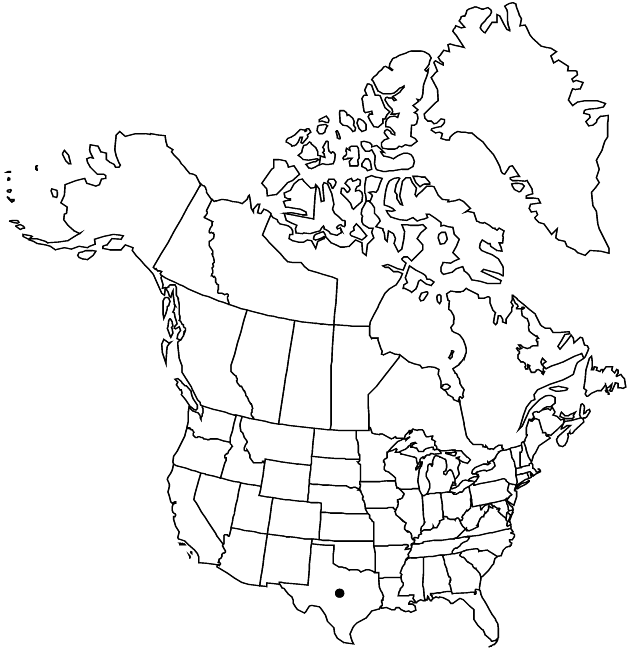Difference between revisions of "Perityle cinerea"
Sida 3: 278. 1968.
FNA>Volume Importer |
imported>Volume Importer |
||
| (6 intermediate revisions by 2 users not shown) | |||
| Line 8: | Line 8: | ||
}} | }} | ||
|common_names=Gray rock daisy | |common_names=Gray rock daisy | ||
| − | |basionyms={{Treatment/ID/ | + | |special_status={{Treatment/ID/Special_status |
| + | |code=E | ||
| + | |label=Endemic | ||
| + | }}{{Treatment/ID/Special_status | ||
| + | |code=C | ||
| + | |label=Conservation concern | ||
| + | }} | ||
| + | |basionyms={{Treatment/ID/Basionym | ||
|name=Laphamia cinerea | |name=Laphamia cinerea | ||
|authority=A. Gray | |authority=A. Gray | ||
| + | |rank=species | ||
| + | |publication_title=in W. H. Emory, Rep. U.S. Mex. Bound. | ||
| + | |publication_place=2(1): 82. 1859 | ||
}} | }} | ||
|synonyms={{Treatment/ID/Synonym | |synonyms={{Treatment/ID/Synonym | ||
|name=Pappothrix cinerea | |name=Pappothrix cinerea | ||
|authority=(A. Gray) Rydberg | |authority=(A. Gray) Rydberg | ||
| + | |rank=species | ||
}} | }} | ||
|hierarchy=Asteraceae;Asteraceae tribe Heliantheae;Asteraceae (tribe Heliantheae) subtribe Peritylinae;Perityle;Perityle sect. Pappothrix;Perityle cinerea | |hierarchy=Asteraceae;Asteraceae tribe Heliantheae;Asteraceae (tribe Heliantheae) subtribe Peritylinae;Perityle;Perityle sect. Pappothrix;Perityle cinerea | ||
| Line 31: | Line 42: | ||
|distribution=Tex. | |distribution=Tex. | ||
|discussion=<p>Of conservation concern.</p><!-- | |discussion=<p>Of conservation concern.</p><!-- | ||
| − | --><p>Perityle cinerea is found in Pecos, Terrell, and Upton counties. The relatively short, appressed habit seen in some populations may be the result of browsing by sheep. Perityle vitreomontana and P. rupestris var. albiflora are thought to be closely related to the uniquely tomentose-canescent P. cinerea.</p> | + | --><p><i>Perityle cinerea</i> is found in Pecos, Terrell, and Upton counties. The relatively short, appressed habit seen in some populations may be the result of browsing by sheep. <i>Perityle vitreomontana</i> and <i>P. rupestris </i>var.<i> albiflora</i> are thought to be closely related to the uniquely tomentose-canescent <i>P. cinerea</i>.</p> |
|tables= | |tables= | ||
|references= | |references= | ||
| Line 40: | Line 51: | ||
-->{{#Taxon: | -->{{#Taxon: | ||
name=Perityle cinerea | name=Perityle cinerea | ||
| − | |||
|authority=(A. Gray) A. M. Powell | |authority=(A. Gray) A. M. Powell | ||
|rank=species | |rank=species | ||
| Line 54: | Line 64: | ||
|publication title=Sida | |publication title=Sida | ||
|publication year=1968 | |publication year=1968 | ||
| − | |special status= | + | |special status=Endemic;Conservation concern |
| − | |source xml=https:// | + | |source xml=https://bitbucket.org/aafc-mbb/fna-data-curation/src/2e0870ddd59836b60bcf96646a41e87ea5a5943a/coarse_grained_fna_xml/V19-20-21/V21_793.xml |
|tribe=Asteraceae tribe Heliantheae | |tribe=Asteraceae tribe Heliantheae | ||
|subtribe=Asteraceae (tribe Heliantheae) subtribe Peritylinae | |subtribe=Asteraceae (tribe Heliantheae) subtribe Peritylinae | ||
Latest revision as of 21:14, 5 November 2020
Plants 8–25(–45) cm (profusely branched, densely leafy); densely tomentose-canescent. Leaves: petioles 6–10 mm; blades usually broadly ovate to subdeltate, rarely subreniform, 6–15 × 6–18 mm, margins deeply serrate (veins conspicuous). Heads borne singly or in corymbiform arrays, 8–10 × 4–7 mm. Peduncles 3–10 mm. Involucres narrowly campanulate. Phyllaries 8–16, linear-lanceolate to oblanceolate, 4–7 × 1–2 mm. Disc florets 10–15; corollas white, tubes 1–1.6 mm, throats tubular, 2.4–3.2 mm, lobes 0.6–1.2 mm. Cypselae 2.6–3(–3.5) mm; pappi of (10–)14–20 bristles 1–3 mm. 2n = ca. 136.
Phenology: Flowering spring–fall.
Habitat: Crevices, limestone caprock of mesas
Elevation: 800–1300 m
Discussion
Of conservation concern.
Perityle cinerea is found in Pecos, Terrell, and Upton counties. The relatively short, appressed habit seen in some populations may be the result of browsing by sheep. Perityle vitreomontana and P. rupestris var. albiflora are thought to be closely related to the uniquely tomentose-canescent P. cinerea.
Selected References
None.
